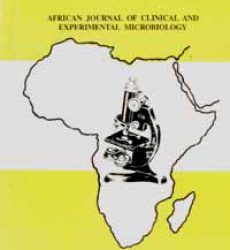*Adebisi, O. O., Gbala, I. D., Akinsolu, F. T., and Olayemi, A. B.
Section of Integrative Bioenergetics Environmental and Ecotoxicological Systems, Department of Microbiology, Faculty of Life Sciences, University of Ilorin, P.M.B. 1515, Ilorin, Nigeria *Correspondence to: oo.adebisi@outlook.com; soji-olusegun@unilorin.edu.ng
Abstract:
Background: Coliform bacteria are majorly introduced into water bodies (river and wastewater) as a result of faecal pollution, agricultural run-offs and several anthropogenic activities. Despite the effectiveness of water treatment methods, pathogens still persist in water; hence the relevance of assessing the ability of these pathogens to survive the lethal actions of physical stresses and the possible impact on antibiotic susceptibility pattern of the organisms. Methodology: The survivability of Escherichia coli strains (NCM3722, FAP1 and ST2747), Enterobacter cloacae GGT036 and Shigella sonnei 53G was assessed in environmental and waste waters for 21 days. The effect of three treatment regimens (UV radiation, solar radiation and boiling) on the survival of the coliforms was evaluated. Also, the antibiogram of the isolates post–UV exposure was assayed. Results: Although there was significant reduction (≥ 3-log) in the population of the bacteria overtime, all the coliforms survived in the waters for 21 days. The effect of UV radiation was significant on all organisms (> 3 log reductions). Solar radiation for 60 minutes had significantly lesser effect than boiling for 15 minutes. Surviving cells of all isolates demonstrated multiple drug-resistance post exposure to UV radiation. Conclusion: This study revealed the ability of coliforms to persist in waters after treatment and proves that UV radiation may not be effective in attenuation of antibiotic resistance.
Keywords: Survivability; Coliforms; Antibiotic susceptibility; Water; Wastewater
Received December 17, 2018; Revised June 2, 2019; Accepted June 3, 2019
Copyright 2019 AJCEM Open Access. This article is licensed and distributed under the terms of the Creative Commons Attrition 4.0 International License (http://creativecommmons.org/licenses/by/4.0), which permits unrestricted use, distribution and reproduction in any medium, provided credit is given to the original author(s) and the source.
Effet des contraintes physiques sur la capacité de survie et la susceptibilité aux antibiotiques post-exposition aux coliformes dans les eaux de surface et les eaux usées
*Adebisi, O. O., Gbala, I. D., Akinsolu, F. T., et Olayemi, A. B.
Section de la bioénergétique intégrative Systèmes environnementaux et écotoxicologiques, Département de microbiologie, Faculté des sciences de la vie, Université d’Ilorin, P.M.B. 1515, Ilorin, Nigeria
*Correspondance à: oo.adebisi@outlook.com; soji-olusegun@unilorin.edu.ng
Abstrait:
Contexte: Les bactéries coliformes sont principalement introduites dans les eaux (rivières et eaux usées) en raison de la pollution fécale, des écoulements agricoles et de plusieurs activités anthropiques. Malgré l’efficacité des méthodes de traitement de l’eau, les agents pathogènes persistent dans l’eau; D’où la pertinence d’évaluer la capacité de ces agents pathogènes à survivre aux actions létales des stress physiques et à l’impact possible sur le profil de sensibilité des organismes aux antibiotiques. Méthodologie: La capacité de survie des souches d’Escherichia coli (NCM3722, FAP1 et ST2747), de Enterobacter cloacae GGT036 et de Shigella sonnei 53G a été évaluée pendant 21 jours dans des eaux environnementales et des eaux usées. L’effet de trois schémas thérapeutiques (rayonnement UV, rayonnement solaire et ébullition) sur la survie des coliformes a été évalué. En outre, l’antibiogramme des isolats après l’exposition aux UV a été testé.
Résultats: Bien qu’il y ait eu une réduction significative (≥ 3 log) de la population de bactéries en heures supplémentaires, tous les coliformes ont survécu dans les eaux pendant 21 jours. L’effet du rayonnement UV était significatif sur tous les organismes (réductions de> 3 log). Le rayonnement solaire pendant 60 minutes a eu un effet significativement moindre que celui d’ébullition pendant 15 minutes. Les cellules survivantes de tous les isolats ont démontré une résistance multiple aux médicaments après une exposition aux rayons UV.
Conclusion: cette étude a révélé la capacité des coliformes à persister dans les eaux après traitement et prouve que le rayonnement UV peut ne pas atténuer efficacement la résistance aux antibiotiques.
Mots-clés: Survivabilité; Les coliformes; Sensibilité aux antibiotiques; Eau; Eaux usées
Download full journal in PDF below

